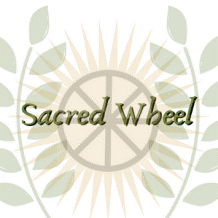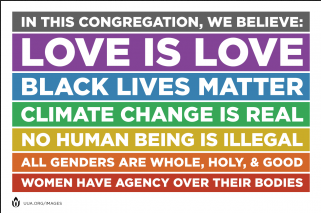Sacred Wheel
Visit us on Facebook
 We are the Earth-based spirituality group within Accotink UU Church
We are the Earth-based spirituality group within Accotink UU Church
Some of us at Accotink find a strong spiritual source in nature and express our “respect for the interdependent web of all existence” through ceremonies based on traditions that acknowledge and celebrate the eternal cycle of the seasons. Borrowing the pattern from other traditions, we too celebrate the sacred wheel of seasons at eight points of the earth’s trip around the sun. We incorporate symbols and rituals from a variety of traditions into the design of our own ceremonies.
Contact sacredwheelauuc@gmail.com to see how you can get involved!
Sacred Wheel Ceremonies Celebrated at Accotink
Imbolc / Lupercalia
Imbolc is the celebration of the strengthening of the Sun as we are past the Winter Solstice and the days are getting longer! It is also called Candlemas, St. Brigit of Ireland’s Day, and in the Roman calendar Lupercalia, celebrating the time of the wolf who nursed the twins Romulus and Remus. Purification, then inspiration and creativity are the order of the day. It is also a time of healing for mind, body and spirit. Bring your worries and your small items to place on the altar for blessing as you are also blessed, and stay afterward for food and drink as we enjoy the first stirrings of Spring!
Spring Equinox / Ostara
Spring Equinox is the time of Equal Night (hence the word equi +nox) and Equal Day, 12 hours of light and 12 hours of darkness. It is the time of turning from the dark of the year to the light, when the Earth greens again and it is warm outside!
The name Ostara is German but also Saxon, from the Goddess of Spring, Eostre. Her celebrations are those of new life of all kinds, eggs, rabbits, and flowers making their appearance again. From Eostre we get the English word Easter. Many cultures celebrate the Spring Equinox, but here in the USA we equate Easter to both Passover and to the celebration of Jesus rising from the dead in the Christian tradition.
Beltane / May Day
Welcome in May! Bring the children and have fun dancing the Maypole. Ribbons will be provided or bring your own 9-yard length; the more colors the prettier! Find out why June is the month to marry, and why we call this month May. Learn about the Floralia, and celebrate the wedding of the Gods and the start of Summer. Leap the flaming cauldron and banish what troubles you at Beltane, the Fire Festival to start life anew.
Summer Solstice / Midsummer
Summertime! We celebrate Summer Solstice, the longest day of the year, and the offering of the first fruits (think strawberries) in gratitude for the bounty that the Earth provides, and as the Full Moon of this month is called the Honey Moon, to appreciate the honey that the bees are now making, allowing us to make mead, that most famous of ancient drinks! For three days the Sun, called Sol in Latin, appears to stand still, or is static, in its height in the sky, therefore Sol Stitia, or Solstice. Summer Solstice, or Midsummer, is also called Litha (pronounced LEE-thuh). It is a time to enjoy the light before the true heat and humidity for which DC is famous, and to enjoy the green trees and the flowers that we hope will mean an abundant harvest for all.
Lammas / Lughnasadh
Lammas comes from Old Norse Hlaf Mass, meaning Loaf Mass, and is the celebration of the wheat harvest. The first of the harvest festivals of the year, we at Sacred Wheel celebrate with a Loaf Toss and the sacrifice of a loaf of bread made from the new wheat. John Barleycorn of the famous song also comes from this time, when the grain is gathered and brewed into both beer and whiskey.
Lughnasadh, pronounced loo-NAH-sa, is from the Celtic tradition of giving thanks to the Goddess Tailtiu for clearing the land for the Irish to farm, and thus feeding the people. It is marked with games of skill, feats of strength, trading, marketing, and matchmaking! Today’s county and state fairs (think Highland Games with the tossing of the caber and tractor pulls) are our modern American celebrations.
Fall Equinox / Mabon
Sacred Wheel invites everyone to celebrate the original Thanksgiving. The second and most important of the agricultural harvest festivals occurs with the Fall Equinox, when the Earth begins the dark time of the year with equal hours of day and night. This is also the harvest of the wine grapes, so come join us in raising a glass to Dionysus in celebration! Dionysus is perhaps most important as God of Transformation, appropriate to the season of cutting down. We recognize and remember, as always, that what appears as death is merely the preparation for rebirth, that what is reaped at the harvest will become seed for the next year. And we remember the mystery—there is no death; all that dies will be reborn. And for this too, we give thanks.
Samhain / Halloween
This congregational service presents the true essence of Halloween, also called All Hallow’s Eve and Samhain (pronounced SOW-win) in Gaelic. It is All Soul’s Night when the dead come back to visit the living, and we honor all our loved ones who have passed over to the other side of the Veil. In keeping with the fine tradition of extorting candy from strangers, we will have a children’s costume parade where the kids will collect money for UNICEF during the service. After the kids go downstairs to have fun activities, the adults will meditate on those who have passed over. Everyone is encouraged to come in costume, and after service, we will have a party! Games for adult and children, food and drink, all are welcome for a fun time!
Winter Solstice / Yule
The name Yule derives from one of the many names of Odin, the Norse All-Father. The Winter Solstice is the shortest day and longest night of the year, when our planet is at its furthest tilt away from our star. This is cause for celebration, because it means that from now on the days will be longer and the nights shorter! Enjoy the story of the Mistletoe and why we kiss under it, and the origin of Santa Claus, followed by an appearance of the jolly old elf himself!


